Will Ruslan Ponomariov become the First Teenage Champ?
The chess world has never seen a teenage World Champion, but with Ruslan Ponomariov advancing to the finals of the FIDE Championship, we are faced with the very real possibility that the 18-year-old Ponomariov will end up as the FIDE World Champion. As a sequel to my article last April about 70-year-old Viktor Korchnoi and his place among the greatest older chess players ever, it seems like an ideal time to consider Ponomariovís place among the great young players in chess history.
This analysis is based upon my Chessmetrics ratings system, which calculates historical ratings going back to the mid-1800ís, with built-in corrections for rating inflation. From 1851 to 1950, the ratings are only calculated once per year, but in more recent times they are calculated with increasing frequency, including once per month from 1980 to 1998 and once per week since 1999. With such frequent rating calculations, it is much easier to evaluate the progress of rapidly-improving players than with the older FIDE rating lists, which were only published once a year in the 1970ís and twice a year in the 1980ís and 1990ís. In addition, since my rating lists go back more than a century earlier than the initial FIDE ratings, it is now possible to compare the early strength of famous teenagers like Bobby Fischer and Boris Spassky against the great youngsters of the past quarter century.
You can read a lot about these ratings elsewhere on this site, but for now let me just say that a 2800 rating, whether it be in 1888 or 1999, corresponds approximately to the level of a typical world champion. In some years, such as the mid-1930ís and early 1960ís, the top-rated player in the world had a rating well below 2800. At other times, notably from 1918 to 1928 (when both Emanuel Lasker and Jose Capablanca were rated over 2800) there were multiple players at the strength of a "typical world champion". The most extreme example of this has been in the past six years, where Garry Kasparov, Vladimir Kramnik, and Viswanathan Anand all have had ratings of 2800 or higher, culminating in the list six months ago where all three players had ratings between 2840 and 2847. Just remember that these are not official FIDE ratings, though I believe my ratings to be more statistically accurate than the FIDE ratings.
It is very interesting to compare the age-aligned career rating graphs of the strongest teenage players ever. It is clear that Kasparov and Kramnik have set the standard against which all future youngsters will be measured. Up to their 17th birthdays, Judith Polgar was fully as strong as the 2 Kís, but her rating leveled off afterwards, in marked contrast to the continual improvement shown by Kasparov and Kramnik and most of the other players on the following graph. Notice the recent steep climb shown by Ponomariov, and the fact that only Kasparov and Kramnik had higher ratings on their 18th birthday than Ponomariov did on his 18th birthday (this past October). On this graph, the x-axis is age and the y-axis is Chessmetrics rating.
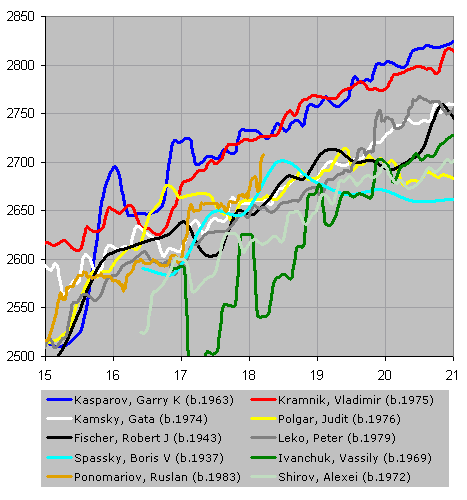
From a casual study of world top ten lists, it would seem that Garry Kasparov had the best teenage career of any player in chess history. He was the only teenager ever to be ranked first in the world, spending ten months as #1 at age 19 in 1982 and 1983. Kasparov also spent more time in the top ten (3.6 years) than any other teenage player, ahead of Kramnik (2.9 years), Spassky (2.6 years), Fischer (1.8 years), and Gata Kamsky (0.8 years). Kramnik is the only player other than Kasparov to be ranked #2 as a teenager, although Vassily Ivanchuk (#3 at age 19), Fischer (#4 at age 19), Spassky (#5 at age 18) and Peter Leko (#5 at age 19) all made it into the top five before turning twenty. Incredibly, Kasparov was already ranked as one of the top ten players in the world by early 1979, slightly before his sixteenth birthday.
Nevertheless, it should be pointed out that the teenage Kramnik faced more obstacles than the teenage Kasparov. First of all, the teenage Kramnik had the older Kasparov to contend with! It was easier for the teenage Kasparov to surpass #1 Anatoly Karpovís rating in 1982 than it was for the teenage Kramnik to surpass #1 Kasparov in 1994, since Kasparov in 1994 was rated about 100 points higher than Karpov in 1982 (even after correcting for inflation). Further, the top ten has gotten more and more crowded in recent years, so that it is harder and harder to break into the top ten, even with a very high rating. You can see from the above graph that Kasparov and Kramnik show almost identical strength progression between ages 17 and 21, though Kasparovís peers in the early 1980ís were not as strong and thus he was a more "dominant" teenager than Kramnik.
If youíre wondering about Bu Xiangzhi (who turned 16 in mid-December) and Teimour Radjabov, I can tell you that Bu Xiangzhi had a 100-point increase in the final few months before his 14th birthday, breaking into the worldís top 300 and peaking at about a 2530 Chessmetrics rating, but his rating has not improved in the last two years and has still never reached 2540. And Radjabov will not turn 15 until March, although only three players ever had a higher rating on their 14th birthday than he did. If youíre interested in more details, go to my Chessmetrics website and look around.
However, letís get back to Ruslan Ponomariov. Although Kramnik and Kasparov are clearly the strongest 18-year-old players ever, it is not so clear who the third-strongest 18-year-old was. Up until now, that distinction was probably held by Boris Spassky, who reached #5 in the world and a 2700+ rating before he was 18.5 years old, winning the junior world championship in 1955. However, the next few months and years saw a slow decline in Spasskyís rating and he didnít reach the 2700 level again until more than five years later. The next-youngest player to reach 2700 was Bobby Fischer, who was ranked fourth in the world with a 2709 rating a few weeks after his nineteenth birthday in March 1962.
Ponomariov has now surpassed them both, in strength though not quite in world rank (remember that the top ten is a lot more crowded than it was forty or fifty years ago when Spassky and Fischer were teenagers). Barely two months after his 18th birthday, Ponomariov already has surpassed the 2700 (Chessmetrics) mark and it is clear from the slope of the orange line (Ponomariovís) in the above graph that he will very soon be in previously-uncharted territory if he continues to improve at the same pace. On the other hand, his historical graph is shaped more like a staircase than other playersí graphs, with big leaps forward followed by sustained periods of minimal improvement. So it is quite conceivable that Ponomariovís rating will level off without any improvement for many months. Nevertheless, he currently appears to be stronger at his age than anyone in chess history (at the same age) other than Garry Kasparov and Vladimir Kramnik.
Although these historical comparisons of individuals are quite intriguing, I noticed some other interesting age-related trends. If you look at the composition of the top ten during each decade, broken into four age groups (younger than 30, 30-39, 40-49, and 50 or older), it becomes very clear that the top ten has become almost exclusively the domain of players in their thirties or younger.
From 1940 to 1990, the top ten lists included about 10% players who were 50 or older, and 25% players who were 40-49 years old. However, in the 1990ís, fully 90% of the players on the top ten lists were younger than 40, and the vast majority of those players were in their twenties or even younger.
Currently Garry Kasparov (who will be 39 in April) is the oldest player in the top ten, and we havenít seen a top-ten player aged 40 or more since Anatoly Karpov fell out of the top ten in 1999. And before Karpov, you have to go back several years to find another top-ten player who was 40 or older (Jan Timman in 1992).
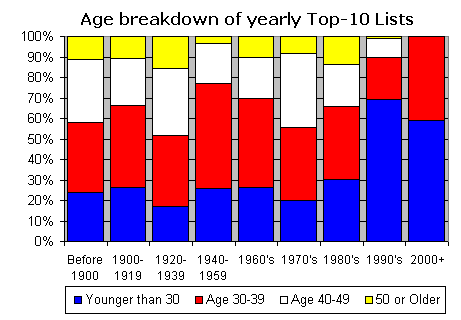
Considering this trend, it seems almost inevitable that we would soon see teenagers breaking into the top ten in greater numbers, and eventually challenging for the world championship. It is interesting to speculate about the causes of this trend. It hardly seems likely that chess has somehow turned into a more athletic game than it used to be, even with the faster time controls! Perhaps the younger generation is more comfortable with computers, and thus more skilled at using them to improve. Or perhaps the game has become much more tactical, and the superior positional understanding of the older players is less decisive.
As a footnote, I should point out that Max Euwe was the first teenager to break into the world top ten, ranked #9 in the December 1920 list at the age of 19.6 years. This mark stood for more than three decades until Spassky reached the #9 rank at the age of 17.4 in June of 1954. Bobby Fischer failed to reach the top ten at such a young age; he eventually reached the top ten thanks to a #10 rank in June of 1961 at the age of 18.3. The fourth teenager ever to reach the top ten was Kasparov, at 15.9 in the February 1979 list, and then several teenagers in the 1980ís and 1990ís made it into the top ten at various times, though not nearly as young as Kasparov had been in 1979.
You might be wondering about the history of teenage players breaking into the top-fifty, rather than the elite level of the top-ten. Well, Jonathan Penrose was ranked #40 in December 1950 at the age of 17.2, Spassky was ranked #23 in June 1953 at the age of 16.4, Fischer was ranked #23 in December 1958 at the age of 15.8, and Kasparov was ranked #40 in December 1978 at the age of 15.7. This record was threatened by Gata Kamsky, who reached the #50 rank a day before his 16th birthday, and then finally broken by Vladimir Kramnik, who was ranked #34 in January 1991 at the age of 15.6. Nobody has seriously threatened Kramnikís record in the eleven years since then; Judith Polgar didnít break into the top fifty until she was 16.5, and Alexander Morozevich, Peter Leko, Ruslan Ponomariov, and Alexander Grischuk were all past their 17th birthdays by the time they made it into the top 50.
Another way to explore this issue is to group players together based on their year of birth. It is very interesting to note that in the quarter century, starting with Euwe losing his title back to Alexander Alekhine, and finishing with the end of Mikhail Botvinnikís reign as champion, very few players were born who eventually reached the top five. That translates to a smaller number of elite players currently between the ages of 40 and 65. Other than Bobby Fischer and Anatoly Karpov, only Alexander Beliavsky, Artur Jussupow, Jan Timman, Rafael Vaganian, and Ulf Andersson have spent any significant time in the top five, and none of them seem at all likely to reach the top five again. Here is a graph of the top ten careers for players born between 1938 and 1962, where the x-axis tells you what their age was, and the y-axis tells you their Chessmetrics rating.
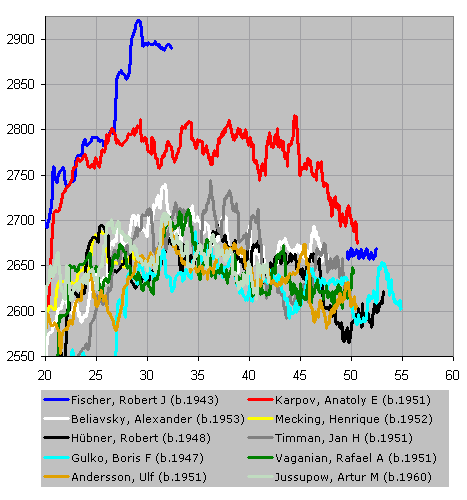
You can see that there are very few spots on this graph where anyone other than Karpov or Fischer topped the 2700-mark, indicating that none of those other players were particularly dominant. By contrast, the quarter century leading up to the Alekhine-Euwe match (players born 65 to 90 years ago) saw the birth of players like Botvinnik, Petrosian, Tal, Smyslov, Korchnoi, Spassky, Reshevsky, Fine, Keres, Polugaevsky, Bronstein, Geller, Larsen, Portisch, Stein, and Kotov, all of whom spent significant time in the worldís top five. And most of those players spent a long time above the 2700-mark.
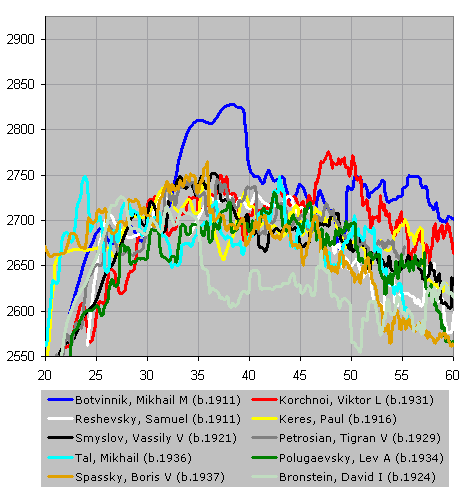
And the quarter century starting with Petrosianís reign (players born 15 to 40 years ago) has already given us top-five names like Kasparov, Kramnik, Anand, Ivanchuk, Gelfand, Short, Salov, Adams, Shirov, Leko, Topalov, Kamsky and Bareev. Plus, the future first-time entries into the top-five will also presumably come from that younger generation, for instance Morozevich, Kasimdzhanov, Ponomariov, Polgar, Svidler, Khalifman, Lautier, van Wely, Tkachiev, and Grischuk. Here is a final chart showing the top ten careers of players born since 1963 (only shown through age 40, since none of them are that old yet).

Again, we see most of these players spending the majority of their adult chess careers above the 2700 level. This is not merely some sort of rating inflation at work; notice from the previous graph that there were many players born from 1911 to 1937 who also had very long stretches of 2700+ ratings. I donít know how to explain this relative gap in chess talent in the generation born between 1938 and 1962, other than to say that perhaps it is related to the aftermath of the Second World War, and/or changes in Soviet chess schools. Also, before we leave this last graph, notice the incredible rating synchronization that continues between Kasparov and Kramnik at similar ages, right up to Kramnikís present age.
One final point is that we can detect a gradual trend toward chess players reaching their peak level at a progressively younger age. Eighty years ago, it would have been preposterous to talk about a 32-year-old chess player being "past his prime". Many of the players born before 1911 didnít reach their peak level until after turning forty.

And by looking at the earlier graph with Botvinnik and Korchnoi, you can see that players of that generation tended to peak between 35 and 40. Continuing the trend, the generation featuring Fischer and Karpov seems to show peak levels between ages 30 and 35.
Itís harder to draw conclusions about the current generation (from the latest graph), since none of them are even 40 years old yet. However, it seems safe to say that not very many of the top players are showing much improvement after turning 27 or 28, so it could easily be argued that players born after 1960 tend to reach their peaks between the ages of 25 and 30. Thus it is quite possible that both Vassily Ivanchuk and Alexei Shirov, whose maximum ratings occurred when they were 27, are indeed past their peak, strange as that may seem.
Of course, it may take many years for a player to drop very far below their peak. Ivanchuk, for instance, has been very impressive during the FIDE championships, and seems to be the favorite to defeat Ponomariov and become FIDE World Champion. My Chessmetrics ratings give Ivanchuk about a 65% chance to win, whereas Garry Kasparov rates Ivanchukís prospects at about 55%. On the other hand, the Professional ratings (which are weighted performance ratings of each playerís 100 most-recent-games) had Ponomariov #7 in the world already on December 1st, with Ivanchuk 19 points back at #11, so presumably those ratings would only give Ivanchuk something like a 45% chance to win the match.
There is a lot more that could be said about the age factor, but I suppose thatís enough for now. You can send me e-mail at jeff@chessmetrics.com if you have any questions, comments, or suggestions. In closing, let me leave you with three more graphs. The first one illustrates the age-aligned careers of nine world champions and one near-miss (Viktor Korchnoi), between ages of 15 and 70.
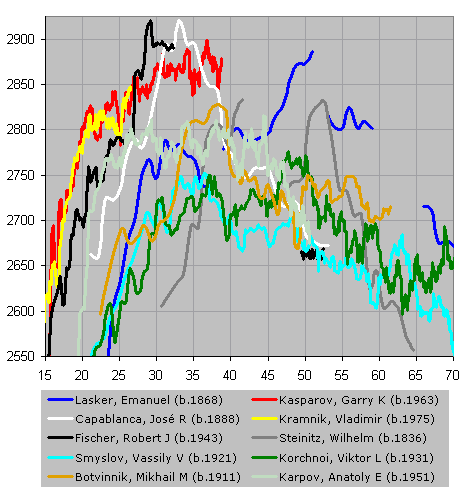
The second one shows the progression of ten of the best careers after the age of 50. Last year I wrote an article about Viktor Korchnoi's place in history among elderly chess players, but that was with a smaller set of games, not based on the ChessBase database. So here is an updated graph using my more accurate ratings. You can see that Korchnoi probably had the greatest career from ages 60-69 of anyone in history, more impressive than either Emanuel Lasker or Vassily Smyslov. It remains to be seen whether Korchnoi will have the greatest-ever career from ages 70-79. Probably that distinction is currently held by either Vassily Smyslov, Sammy Reshevsky, or Miguel Najdorf, although the three are very similar.
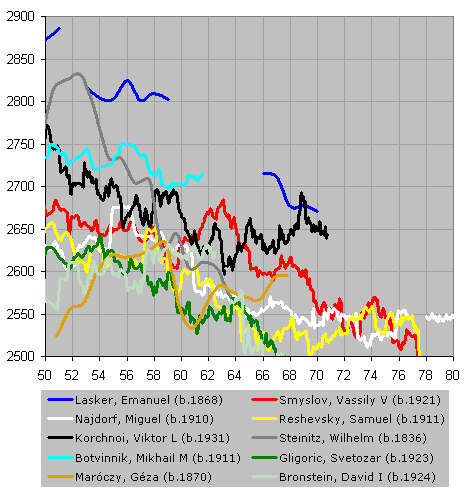
The third one illustrates the progress of players I mentioned earlier (like Ponomariov, Radjabov, and Bu Xiangzhi) between the ages of 12 and 16.


